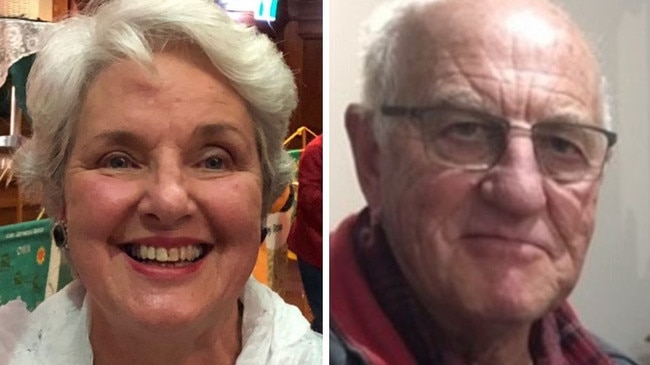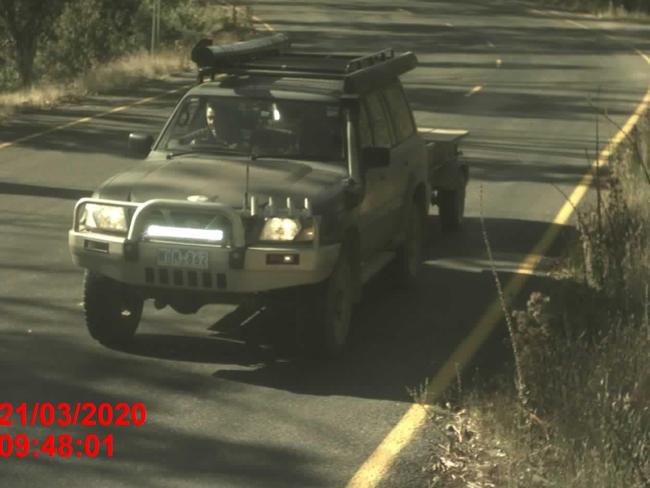Greg Lynn’s phone ‘switched off’ for 46 hours when he returned to High Country
Accused killer pilot Greg Lynn’s mobile phone was “switched off” for nearly two days as he returned to the High Country to burn Russell Hill and Carol Clay’s remains, a court has heard.

Police & Courts
Don't miss out on the headlines from Police & Courts. Followed categories will be added to My News.
Accused killer pilot Greg Lynn’s mobile phone was “switched off” for nearly two days as he returned to the High Country to burn Russell Hill and Carol Clay’s remains, a court has heard.
The former Jetstar captain, 57, is standing trial in the Supreme Court for the murders of Mr Hill, 74, and Mrs Clay, 73, who vanished during a camping trip to the Wonnangatta Valley in Victoria’s High Country in March 2020.
Matthew Sorell, a digital forensic expert, examined Mr Lynn’s phone data and records, telling the court on Monday his handset last connected to a cellular network in Thomastown at 11.42am on November 18, 2020.
His phone “switches off” until two days later, when it reconnected to cell towers near Rowville and Heathmont about 9.48am, the jury was told.

“When I say switches off I can’t eliminate the following possibilities, the phone could have been switched off, the phone could of been put into flight mode, the battery might of gone flat,” he said.
“I don’t think that the phone was damaged because it comes back on a couple days later.”
Asked what he made of that gap, Dr Sorell said he feared he would be speculating.
“All I can say is the phone goes off the network and when it comes back on, it’s ... at a location on the eastern side of the city,” he said.
“There’s a 46-hour gap.”

After his arrest, Mr Lynn told police he returned to remote bushland near Union Spur Track in November 2020 to burn what was left of the missing campers’ remains.
Under cross-examination by defence barrister Michael McGrath on Monday, Dr Sorell said he could not say where the handset was when it was disconnected.
But he agreed it was not “inconsistent” with a scenario in which it was turned off or put in flight mode as it returned to the alpine region.
Dr Sorell also examined data from Mr Hill and Mrs Clay’s phones, with the jury taken through various maps plotting their movements as they set off for a camping trip in the Wonnangatta Valley.
The data showed the couple meeting at Pakenham on the morning of March 19, 2020, before they travelled east then north into the High Country.
They lost signal after last connecting to a Hotham Heights cell tower around midday.
Dr Sorell said Mrs Clay’s phone did not reconnect to the network, but Mr Hill’s handset came back online around 9.30am on March 21 as it travelled along the Great Alpine Road — the morning after he was allegedly murdered.
Police connected Mr Lynn to the alleged murders after he was captured on traffic cameras near Mount Hotham at a similar time as Mr Hill’s phone came back onto the network.
His phone was never found and Mr Lynn allegedly disposed of it close to where it last had a signal.
Missing campers’ remains were completely ‘obliterated’
Earlier: The charred remains of Russell Hill and Carol Clay were so “obliterated” that their cause of death was impossible to determine, a forensic expert has told a jury.
Melanie Archer, a forensic pathologist and insect expert at the Victorian Institute of Forensic Medicine, was assigned the grisly task of examining insect remnants found alongside the missing campers’ remains in remote bushland off Union Spur Track, near Dargo, in late 2021.

Now in the third week of evidence, Dr Archer on Monday told the trial thousands of bone fragments belonging to Mr Hill and Mrs Clay were so “obliterated” that it was impossible to determine how they had died.
“Whatever has caused their death has been masked by the changes brought about by the burning and fragmentation,” she said.
“You’re left with undetermined as your only choice.”

According to Mr Lynn’s account, Mrs Clay was accidentally shot in the head as the two men struggled over a shotgun.
The ex-pilot claimed Mr Hill then came at him with a knife before he too was accidentally killed when he fell on to the blade during a struggle.
Fearing his life would be “screwed”, Mr Lynn’s defence barrister Dermot Dann KC previously told the jury his client then dumped their bodies at the Union Spur Track site before returning eight months later where he set fire to their remains.
On Monday, Dr Archer, who is also a forensic entomologist, said her examination of blow fly “puparia” — the insect’s outer casing as it grows from a maggot to a fly and similar to a cocoon — found alongside the remains suggested some decomposition had taken place before the bodies were burnt.

Under cross-examination by defence barrister Mr Dann, she agreed her findings were consistent with Mr Lynn’s account that he had burnt their remains but other explanations could not be ruled out.
“It’s a plausible explanation and is consistent with the evidence I have seen,” she said.
Last week the trial heard from several forensic experts who were involved in the search, recovery and identification of Mr Hill and Mrs Clay’s remains.
The jury was told DNA analysis revealed a bone from Union Spur Track likely belonged to Mr Hill, while a skull fragment from Bucks Camp — where the alleged murders took place — likely belonged to Mrs Clay.
The trial, which could last for up to six weeks, continues.



